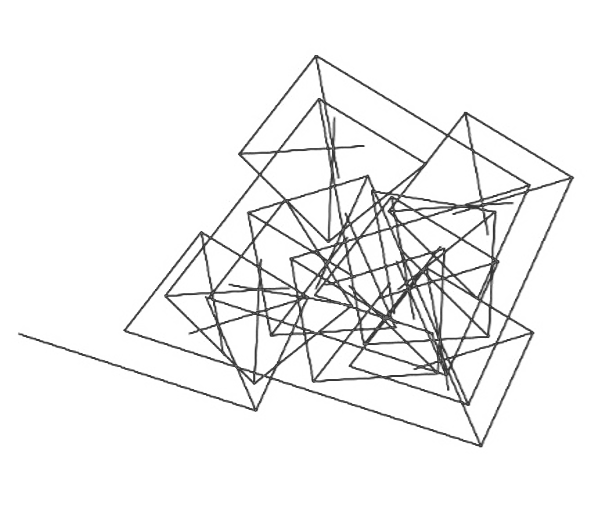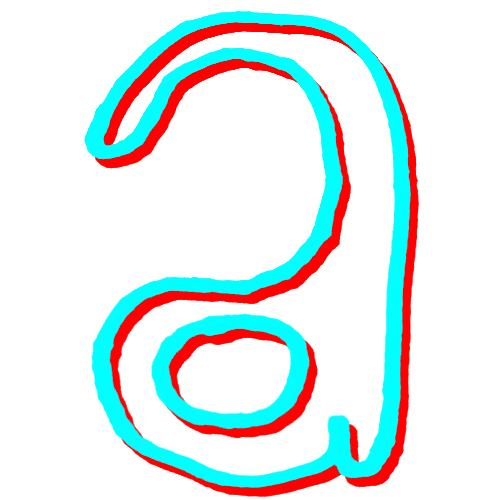On Elizabeth Bishop’s “Vague Poem [Vaguely Love Poem]”
A crystal is an example of an ordered system
In puzzling over fractal still, or considering the shape of Nightwood, or topological permutations, iterations of descriptions I can use to write about a novel or poem, what the sentences or lines “make,” themselves, not the images conjured but the form moving along (?), or perhaps the way the images turn in my mind, like a plant unfurling or something, or a fractal on a plane, or, in this case, where I’m going, a crystal—this is still a figuring out and figuring for (giving shape). I mean, instead of arguing, for example, that Elizabeth Bishop’s “Vague Poem (Vaguely love poem)” is crystalline (or more specifically barite, if that’s the rock she’s writing about, which is kind of pinkish and vaginal and that’s where we end up at the end of the poem), I’d like to consider the shape of a response to a novel or poem as it relates to a potential shape we might use to describe it.

Structure(s):

“Vague Poem (Vaguely love poem)”
I know that this is a manuscript poem and maybe I’m doing Bishop a disservice by looking too closely. But I think I’ll look at its form—or forms or particularities—only loosely, as it’s a loose poem, maybe it’s vague. The poem includes uncertainties, clarifications, and repetitions that reflect (or act as attempts to comprehend) the transformation process of the object the speaker is trying to learn about or at least see. And the speaker imagines the object forming, pictures its mutation in her mind in memory and in a present moment. And that’s it too—the object, sand, becomes another thing, a crystal that looks like a rose—over time—in the way the speaker recognizes, later, that it looks like a nipple or a vagina. The poem’s moves through time, information, and the idea of the rock rose itself allows the reading I’ll give it, I think, even though it’s unpublished (or unfinished).
The trip west—
—I think I dreamed that trip.
They talked a lot of “Rose Rocks”
or maybe “Rock Roses”
—I’m not sure now, but someone tried to get me some.
(And two or three students had.)
She said she had some at her house.
—I think I dreamed that trip.
They talked a lot of “Rose Rocks”
or maybe “Rock Roses”
—I’m not sure now, but someone tried to get me some.
(And two or three students had.)
She said she had some at her house.
If
the “Rose Rocks” or “Rock Roses” the speaker is remembering in the opening
lines of the poem are barite roses, or barite-sand rosettes, they’re formed
from water carrying barite moving up through sandstone. The water then
evaporates, causing barite crystals to grow between quartz sand grains and form
discs (“Rose Rocks”). Barite’s crystalline structure is called “orthorhombic
dipyramidal.” Crystals have habits, meaning the shapes they take, and
barite rose’s shape’s habit is “other” on this
mineral identification website.
Uncertainties abound from the start: the speaker thinks she dreamed a trip west: a double unknown. Then she can’t recall the name of the rocks as
well as whether or not “someone tried to get [her] some” even though the next
three stanzas are about that someone getting her some (and I think we can also read
“get some” with present-day innuendo). The word “some,” an indefinite pronoun, meaning an unknown or immeasurable quantity of an understood thing
(the referent for the pronoun), is repeated in lines five and seven “someone…
some” and “she had some.” The
uncertainty continues (“two or three students”) also in the second stanza when
the speaker is trying to remember or describe the house “someone” takes her to.
—A ramshackle house.
An Army house?—No, “a Navy house.” Yes,
that far inland.
An Army house?—No, “a Navy house.” Yes,
that far inland.
The rock roses aren’t where “someone” thought they were. And then, in the
third stanza, uncertainty becomes clarification, or reiteration, through
dialogue, parentheticals, em-dashes, ellipses… Neither the speaker nor
“someone” knows what they are seeing. The rose rock is only “a kind of one”
anyway. The speaker sees only “[f]aintly” “faint glitters.” The rock is only
“rose-like.” There are multiple words for seeing: a command “See—”; a gesture:
“you can see here”; purposeful looking: “make out”; “apparently”—but each of
these will not yield understanding. Because the speaker and “someone” are not
sure if the rock is really a rock rose, or it isn’t one quite yet. The starts
and stops of knowing and not in this stanza give in at the final line to
“secret, powerful.” A settling in the unknown, or giving it up to magic.
Until the next stanza: The speaker here tries in vain to see the crystal mechanism at work: “I almost saw it: turning into a rose.” The rock rose is more rock than rose, without “intervening / roots, stems, buds.” Which brings the speaker to the preciseness of crystals, so different from a mass of plant matter.
Until the next stanza: The speaker here tries in vain to see the crystal mechanism at work: “I almost saw it: turning into a rose.” The rock rose is more rock than rose, without “intervening / roots, stems, buds.” Which brings the speaker to the preciseness of crystals, so different from a mass of plant matter.
Crystalography and its laws:
something I I once wanted badly to study,
until I learned that it would involve a lot of arithmetic, that is, mathematics.
something I I once wanted badly to study,
until I learned that it would involve a lot of arithmetic, that is, mathematics.
Later, as we drank tea from mugs, she found one,
“a sort of one”. “This one is just beginning. See—
you can see here, it’s beginning to look like a rose.
It’s—well, a crystal, crystals form—
I don’t know any geology myself…”
(Neither did I.)
Faintly, I could make out—perhaps—in the dull,
rose-red lump of, apparently, soil,
a rose-like shape; faint glitters… Yes, perhaps
there was a secret, powerful crystal at work inside.
“a sort of one”. “This one is just beginning. See—
you can see here, it’s beginning to look like a rose.
It’s—well, a crystal, crystals form—
I don’t know any geology myself…”
(Neither did I.)
Faintly, I could make out—perhaps—in the dull,
rose-red lump of, apparently, soil,
a rose-like shape; faint glitters… Yes, perhaps
there was a secret, powerful crystal at work inside.
Laws: Crystallinity, being a crystal, means the object’s “atoms are
clustered into geometric forms—cubes, bricks, hexagons, and so on—and that a crystal
is essentially an orderly three-dimensional stacking of these tiny geometric
forms” (Plummer 43). The atoms are “regularly repeating, orderly” (32).
Imagine a lattice, a plane surface, repeated angles at edges of faces, sand hardening into a rose.
Imagine a lattice, a plane surface, repeated angles at edges of faces, sand hardening into a rose.
I want (badly) to hang on the “I
I” in the second line above, but I can see in the manuscript that it’s a
matter of crossing something out between two I’s. I would say the “I I” is an ordered system, or a reiteration
like “arithmetic, that is, mathematics,” meaning the same thing, clarification
through repetition of something the same or slightly different. Or a
transparency (clarify). Or a hesitation about precision: the fine, fixed
structure of a crystal? I. Not I.
In the final stanza, the
speaker is out of memory and in a present moment with “Just now” (she could be
returning to the time of the first stanza (the declaration of remembering or
dreaming)). Her companion here is a third figure, signaled by the switch from
“she” in the memory to “you” “now.” The crystalline, mathematical precision the
speaker wonders about in the stanza before this uncoils into a string of -ing
verbs and participles, again imagining the “unimaginable” transformation of
particles and sand to something rock-like, and further, something rock-like
that looks plant-like, and like another stone (rose-quartz), and then, here,
“flesh beginning,” like breasts, nipples, sex. Despite repetition of word forms
and the word rose, these images aren’t crystalline. The edges are
“unseen.” Objects are more than one thing at once, layers of possible things
the rose rock could be, including itself, including another kind of
rock.
Time in this poem is curious, too. The memory of the speaker’s trip west, encountering the rock roses for the first time, is not set in motion by seeing her lover’s nipples. The nipples looking like rock roses comes later. The memory (when? why?), and then, a layering. Maybe like the barite coming to the surface with water evaporating. Or a crystalline metaphoric retrieval: “exacting roses from the body,” pulling for accuracy, impossibly, in intimacy.
Time in this poem is curious, too. The memory of the speaker’s trip west, encountering the rock roses for the first time, is not set in motion by seeing her lover’s nipples. The nipples looking like rock roses comes later. The memory (when? why?), and then, a layering. Maybe like the barite coming to the surface with water evaporating. Or a crystalline metaphoric retrieval: “exacting roses from the body,” pulling for accuracy, impossibly, in intimacy.
Just now, when I saw you naked again,
I thought the same words: rose-rock; rock-rose . . .
Rose, trying, working to show itself,
forming, folding over,
unimaginable connections, unseen, shining edges.
Rose-rock, unformed, flesh beginning, crystal by crystal,
clear pink breasts and darker, crystalline nipples,
rose-rock, rose-quartz, roses, roses, roses,
exacting roses from the body,
and the even darker, accurate, rose of sex—
I thought the same words: rose-rock; rock-rose . . .
Rose, trying, working to show itself,
forming, folding over,
unimaginable connections, unseen, shining edges.
Rose-rock, unformed, flesh beginning, crystal by crystal,
clear pink breasts and darker, crystalline nipples,
rose-rock, rose-quartz, roses, roses, roses,
exacting roses from the body,
and the even darker, accurate, rose of sex—

Works Cited
Bishop,
Elizabeth. Poems. Farrar, Straus and Giroux, 2011.
Plummer, Charles C., David McGeary, and Diane H. Carlson.
Physical Geology. McGraw Hill, 2005.
“Rose Rocks.” Oklahoma Geological Survey.
http://www.ou.edu/ogs/generalinterest/rose_rocks.
Images:
img 1: from “Rose Rocks” website
img 2: from Physical Geology
img 3: generated by clicking “random” in this “Fractal Machine”
Plummer, Charles C., David McGeary, and Diane H. Carlson.
Physical Geology. McGraw Hill, 2005.
“Rose Rocks.” Oklahoma Geological Survey.
http://www.ou.edu/ogs/generalinterest/rose_rocks.
Images:
img 1: from “Rose Rocks” website
img 2: from Physical Geology
img 3: generated by clicking “random” in this “Fractal Machine”

Kelly Krumrie is a writer and teacher living in Denver, Colorado. Her work appears in DIAGRAM, La Vague, Black Warrior Review, Full Stop, The Explicator, and elsewhere. She writes a monthly column for Tarpaulin Sky Magazine that puzzles over and gives shape to writing, art, and environments that integrate or concern mathematics and the sciences. She is currently a PhD candidate and Fairfield Fellow in English & Literary Arts: Creative Writing at the University of Denver where she serves as a Prose Editor for Denver Quarterly.

